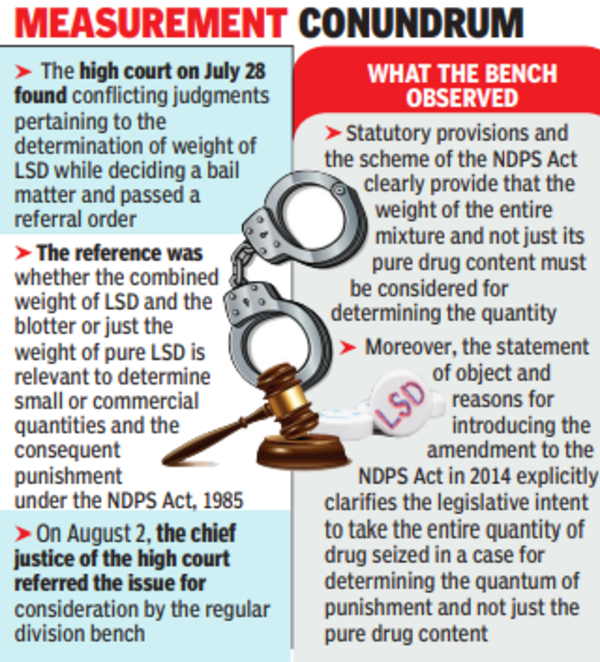Goa HC: When measuring LSD quantity, consider blotting paper weight too

High court of Bombay at Goa
PANAJI: The high court of Bombay at Goa held on Wednesday that when determining if the quantity of LSD is small or commercial, it’s necessary to consider not just the LSD itself, but the combined weight of the LSD and the blotter paper on which it is placed.
“We hold that a blotter paper forms an integral part of the LSD (drug) when put on it for consumption and, as such, the weight of the blotter paper containing LSD will have to be considered for determining a small or commercial quantity of the offending drug under the NDPS Act, 1985,” stated the division bench comprising justices Mahesh Sonak and Bharat P Deshpande. “Further, we also hold that the blotter paper that carries the drug (LSD drops), which facilitates its consumption as a whole, is a preparation, mixture, or neutral substance within the meaning of the NDPS Act, 1985.”

The court added that LSD will have to be classified as a psychotropic substance and not a drug.
Whether blotter paper should be considered when weighing LSD has been the subject of different judicial opinions. In 2020, Justice S K Shinde held that only the weight of the LSD should be counted. But, in NCB vs Anuj Keshwani last year, Justice Revati Mohite Dere held that the combined weight of the blotter impregnated with LSD is determinative in such matters.
Noticing the divergent views, Shinde, in 2022, referred the issue to be placed before a two-judge bench. He had formulated the question whether blotter paper forms an integral part of LSD. This August, the chief justice referred the issues to the regular division bench, leading to Wednesday’s verdict.
Appearing before the division bench, counsels Rizwan Merchant, C Collasso, and K Poulekar submitted that the weight of the blotter paper must be excluded because LSD on a blotter is not a mixture, and a blotter is not a “neutral substance” in the context of LSD. Merchant submitted that after a blotter with LSD drop is placed on the tongue or licked, the LSD paper upon it is infused in the consumer’s body, leaving behind a benign blotter without any traces of LSD on it. He added that such a benign blotter may or may not be swallowed by the consumer.
He submitted that it is an incorrect premise that consumers invariably swallow the blotter along with the LSD drop on it, and that it is impossible to separate LSD once dissolved in a solvent and dropped on a blotter.
However, no material was produced in support of the above submission except to say that there are instances where the blotter is not actually ingested, but spat out.
The court held that the US circuit courts of appeals, addressing this issue, have held that the weight of the entire substance or combined weight should be used to determine the appropriate sentence and not just the weight of the pure LSD on the blotter. “Thus, both nationally as well as internationally, there appears to be a common ground as to the mode on how LSD is usually dealt with in the market or on the streets, or the mode or manner in which LSD is consumed by impregnating it into a blotter and after that, at least in most cases, ingesting the LSD along with the blotter,” the bench held.
“We hold that a blotter paper forms an integral part of the LSD (drug) when put on it for consumption and, as such, the weight of the blotter paper containing LSD will have to be considered for determining a small or commercial quantity of the offending drug under the NDPS Act, 1985,” stated the division bench comprising justices Mahesh Sonak and Bharat P Deshpande. “Further, we also hold that the blotter paper that carries the drug (LSD drops), which facilitates its consumption as a whole, is a preparation, mixture, or neutral substance within the meaning of the NDPS Act, 1985.”

The court added that LSD will have to be classified as a psychotropic substance and not a drug.
Whether blotter paper should be considered when weighing LSD has been the subject of different judicial opinions. In 2020, Justice S K Shinde held that only the weight of the LSD should be counted. But, in NCB vs Anuj Keshwani last year, Justice Revati Mohite Dere held that the combined weight of the blotter impregnated with LSD is determinative in such matters.
Noticing the divergent views, Shinde, in 2022, referred the issue to be placed before a two-judge bench. He had formulated the question whether blotter paper forms an integral part of LSD. This August, the chief justice referred the issues to the regular division bench, leading to Wednesday’s verdict.
Appearing before the division bench, counsels Rizwan Merchant, C Collasso, and K Poulekar submitted that the weight of the blotter paper must be excluded because LSD on a blotter is not a mixture, and a blotter is not a “neutral substance” in the context of LSD. Merchant submitted that after a blotter with LSD drop is placed on the tongue or licked, the LSD paper upon it is infused in the consumer’s body, leaving behind a benign blotter without any traces of LSD on it. He added that such a benign blotter may or may not be swallowed by the consumer.
He submitted that it is an incorrect premise that consumers invariably swallow the blotter along with the LSD drop on it, and that it is impossible to separate LSD once dissolved in a solvent and dropped on a blotter.
However, no material was produced in support of the above submission except to say that there are instances where the blotter is not actually ingested, but spat out.
The court held that the US circuit courts of appeals, addressing this issue, have held that the weight of the entire substance or combined weight should be used to determine the appropriate sentence and not just the weight of the pure LSD on the blotter. “Thus, both nationally as well as internationally, there appears to be a common ground as to the mode on how LSD is usually dealt with in the market or on the streets, or the mode or manner in which LSD is consumed by impregnating it into a blotter and after that, at least in most cases, ingesting the LSD along with the blotter,” the bench held.
FOLLOW US ON SOCIAL MEDIA
FacebookTwitterInstagramKOO APPYOUTUBE
Start a Conversation
end of article









